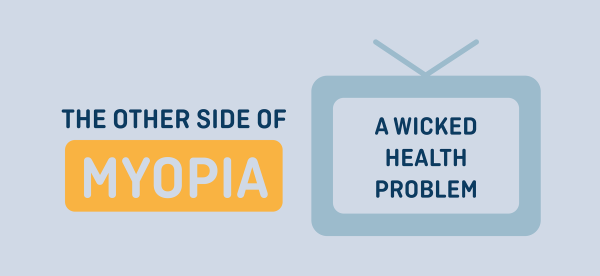The Other Side of Myopia: A Wicked Health Problem

By Jennifer Meerding
Over the years, we have come to know a lot more about myopia, its aetiology and the sight-threatening conditions high myopia is associated with. Research has shown multiple effective treatment programs, visual environmental interventions, and optical and pharmacological treatments to prevent the progression of myopia, all of which aim to keep levels of myopia as low as possible and reduce axial length growth. Besides genetic factors, certain lifestyle habits such as reduced time spent outdoors, screentime exposure and prolonged near vision tasks have been shown to influence the progression of myopia.1
Fortunately, myopia preventive behaviours are receiving increasing attention. The restriction of individual risk behaviours and promotion of myopia protective behaviour – such as spending more time outdoors – will help prevent the development of myopia.
Yet, it is time to observe myopia from a different perspective – let’s call it: The Other Side of Myopia. Myopia goes beyond the definition of not being able to see distant images or objects clearly, as it is more than “just being a refractive error”. This stresses the urge to look deeper at the health behavioural site and societal effect. It may sound easy to reduce screen time and let children spend more time outdoors; however, it is quite a challenge and requires the involvement of as many stakeholders as possible to tackle the problem.
Children today are growing up in a digital world – saturated with smart technology, which is undoubtedly indispensable in our modern society. Screen time is a form of what we call sedentary behaviour. Sedentary behaviour refers to activities that do not increase energy expenditure above resting level and includes activities such as sleeping, sitting, lying down, watching television and other forms of screen-based entertainment.2, 3
However, screen exposure starts at a very young age. The World Health Organization (WHO) published guidelines regarding physical activity, sedentary behaviour and sleep for children under 5 years old.4 It highly recommends not exposing young children to screens. Between ages 2-4, screentime is advised to be restricted to a maximum of one hour, as sedentary behaviour is encouraged for reading and storytelling with a caregiver. For children between the ages of 2-5, it is advised to limit non-educational screen time to about 1 hour per weekday and 3 hours on weekends. For ages 6 and older, the WHO encourage healthy habits and limit activities involving screens.4 Additional research has suggested that excessive screen time exposure during infancy may lead to changes in brain activity. This may result in problems with executive functioning in elementary school. Executive functioning enables us to stay focused and control behaviour, emotions and remember instructions. Children are born with the potential to develop these skills.5-7
Although this is not about myopia yet, it goes beyond. Screen exposure at this age is harmful at a later age, let alone the possible effects it has on axial length growth.
But why do children engage in sedentary behaviour so much? What is it that makes it so difficult to go outside for outdoor activities? Studies in Europe and the United States, show that children spend approximately 8 hours per day sedentary.2 It is important to have regular physical activity as well as low levels of sedentary behaviour, as this is associated with a decreased risk of physical and mental health problems. Moreover, spending 8 hours per day sedentary is a lot for a child. This would call for a different strategy to reduce screen time. For example, school-based interventions to reform educational systems rigorously and increase outdoor time/activities and/or physical activity. Tracking sedentary behaviour during childhood might predict adverse health relationships during adulthood.
However, as straightforward as it may sound to promote physical activity in young children (therefore, reducing sedentary behaviour and thus screen time), the more wicked the health problem gets. Preschool children have poor self-control and tend to follow their parents’ rules and regulations. Parents, in particular, play a significant role in facilitating and regulating their children’s behaviour. It’s interesting to look at their view on potential determinants of their children’s sedentary behaviour and, what determinants children give for engaging in sedentary behaviour. Children and parents indicated several matching potential perceived determinants of their sedentary behaviour: sitting, A because it is the norm and sitting, B because I can work/play better that way is the most important reason. This finding reflects the current societal norm of a sedentary lifestyle.2 When behaviour becomes a habit, in this case sitting, it is automatically activated by environmental stimuli or cues instead of consciously deciding to engage in the behaviour. Parents might unknowingly stimulate their children to sit.2
Now, since we have insights into not only children, and how parents perceive sedentary behaviour, it’s also important to understand parents.
So, how does this relate to myopia? Since parents are role models for their children, it is interesting to find out how parents perceive myopia: what are their attitudes? An interesting study by Hidding et al. (2017) assessed the attitude of parents toward myopia and its associated risks. 46% of the parents considered myopia a health risk to their children, while another identical proportion (46%) regarded myopia as an optical inconvenience. A small number of parents even considered myopia as a sign of intelligence. Furthermore, many parents (76%) recognized the potential of digital technology to impact the eye, particularly as a cause of eyestrain and the need for spectacles.8 An interesting difference was found between myopic and non-myopic parents. Myopic parents limited screentime use in their household more than non-myopic parents. Creating parental awareness can’t be underestimated given the impact parents have on children’s lifestyle choices and behaviour.
The influence of sedentary behaviour is also what we notice during practice. It not only causes myopia, thus visual impairment, but it also negatively influences childhood development in terms of socio-cognitive skills and healthy lifestyle habits. Furthermore, due to reduced outdoor activity and prolonged near work, sedentary behaviour will overall influence body posture and possibly weight.9-11 These modifiable factors are ready for behaviour change; this would call for a different strategy to reduce screen time. For example, school-based interventions to change and implementing a very contrasting educational system in which outdoor time/activities are increased, including physical activity.
Then how can we, as eye care practitioners, provide better care while practicing myopia management? Nearly all young myopes progress especially when taking baseline age, parental history, ethnicity, and sedentary behaviour into account. The younger you start treating myopes with myopia management, the more effective the treatment will be.
Whether the optical intervention is executed with a special spectacle lens design or myopia control contact lenses, both are ways to reduce axial length progression and slow the rate of myopia.
When talking about compliance, it is important to keep the individual child in mind and together find the best optical intervention. Not every child is suitable for wearing spectacles – this could also account for wearing contact lenses.
However, at a younger age, glasses are taken off more quickly, thus influencing the effectiveness of the treatment. Furthermore, high levels of autonomy are experienced by children with Ortho-K, as well as higher levels of compliance because younger patients receive greater parental oversight regarding proper hygiene and lenses worn every night.12,13
Fortunately, there are several ways to manage myopia, including a shift in wearing schedules. Children may want to wear their spectacles but perceive them as a burden during sports or when engaging in physical activities. Therefore, wearing spectacles combined with contact lenses during, for example, weekdays is a finding we should come across more often in the future. This would opt for future research to investigate its outcomes on not only compliance levels but also the effectiveness of myopia management. Furthermore, contact lenses should be chosen for children’s motivation to wear contact lenses when aiming for success, as well as assessing general health and cooperation.
Lastly, myopia management as an optical intervention should be affordable for everyone. Although it is affordable by most, not everyone can afford speciality lens based or contact lens based interventions to manage myopia control. In most European countries, pharmacological interventions are often covered in part by health insurance. When looking at the scope of practice across Europe, we find only a handful of countries in which the social system pays for eye exams in children when the optometrist is doing the examination. No treatment options are covered by health insurance, leaving parents with increasing expenses. There are many stakeholders involved in this growing global health problem. Myopia goes beyond just being a refractive error and implies other strategies, involving not only children, teachers, parents/guardians at the micro level but also municipal health services, local authorities, media, the industry itself at the macro level who should expand cooperation with other professions to create awareness, therefore making a change. Therefore, if we regard myopia as a serious eye condition with irreversible visual impairment in the long term and the government provides reimbursements, myopia management will become even more accessible to every child suffering with myopia. Myopia control is not a product but the approach to control the myopia epidemic.
1. Dhiman R, Rakheja V, Gupta V, Saxena R. Current concepts in the management of childhood myopia. Indian J Ophthalmol. 2022 Aug;70(8):2800–15.
2. Hidding LM, Altenburg TM, van Ekris E, Chinapaw MJM. Why Do Children Engage in Sedentary Behavior? Child- and Parent-Perceived Determinants. Int J Environ Res Public Health [Internet]. 2017 Jun;14(7). Available from: https://pubmed.ncbi.nlm.nih.gov/28640232/
nn
3. van Stralen MM, de Meij J, Te Velde SJ, van der Wal MF, van Mechelen W, Knol DL, et al. Mediators of the effect of the JUMP-in intervention on physical activity and sedentary behavior in Dutch primary schoolchildren from disadvantaged neighborhoods. Int J Behav Nutr Phys Act. 2012 Nov;9:131.
4. Organization WH. Guidelines on physical activity, sedentary behaviour and sleep for children under 5 years of age [Internet]. Geneva PP – Geneva: World Health Organization; Available from: https://apps.who.int/iris/handle/10665/311664 ..
5. Duch H, Fisher EM, Ensari I, Harrington A. Screen time use in children under 3 years old: a systematic review of correlates. Int J Behav Nutr Phys Act [Internet]. 2013;10(1):102. Available from: https://doi.org/10.1186/1479-5868-10-102
6. Law EC, Han MX, Lai Z, Lim S, Ong ZY, Ng V, et al. Associations Between Infant Screen Use, Electroencephalography Markers, and Cognitive Outcomes. JAMA Pediatr [Internet]. 2023 Mar 1;177(3):311–8. Available from: https://doi.org/10.1001/jamapediatrics.2022.5674 .
7. Zhang Z, Adamo KB, Ogden N, Goldfield GS, Okely AD, Kuzik N, et al. Associations between screen time and cognitive development in preschoolers. Paediatr Child Health. 2022 May;27(2):105–10.
8. McCrann S, Flitcroft I, Lalor K, Butler J, Bush A, Loughman J. Parental attitudes to myopia: a key agent of change for myopia control? Ophthalmic Physiol Opt. 2018 May;38(3):298–308.
9. Wolffsohn JS, Calossi A, Cho P, Gifford K, Jones L, Jones D, et al. Global trends in myopia management attitudes and strategies in clinical practice – 2019 Update. Contact Lens Anterior Eye [Internet]. 2020;43(1):9–17. Available from: https://www.sciencedirect.com/science/article/pii/S1367048419302589 .
10. Sherwin JC, Reacher MH, Keogh RH, Khawaja AP, Mackey DA, Foster PJ. The association between time spent outdoors and myopia in children and adolescents: a systematic review and meta-analysis. Ophthalmology. 2012 Oct;119(10):2141–51.
11. Wildsoet, C.F., Chia, A., Cho, P., Guggenheim, J.A., Polling, J.R., Read, S., Sankaridurg, P., Saw, S.M., Trier, K., Walline, J.J., Wu, P.C., Wolffsohn JS. IMI- Interventions for Controlling Myopia Onset and Progression Report. Invest Ophthalmol Vis Sci. 2019;60:M106–31.
12. Cho P, Tan Q. Myopia and orthokeratology for myopia control. Vol. 102, Clinical and Experimental Optometry. Blackwell Publishing Ltd; 2019. p. 364–77.
13. Bui TH, Cavanagh HD, Robertson DM. Patient compliance during contact lens wear: Perceptions, awareness, and behavior. Eye Contact Lens. 2010;36(6):334–9.

